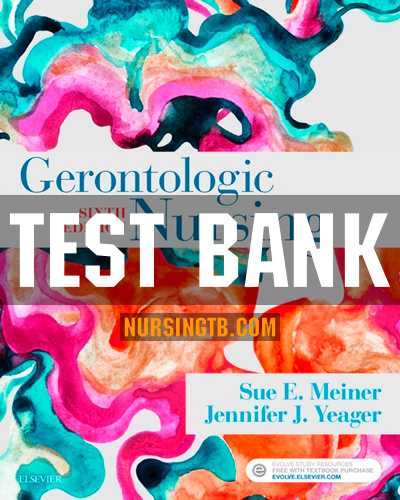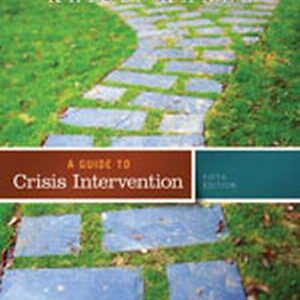Test Bank For Gerontologic Nursing 6th Edition By Meiner
Chapter 01: Overview of Gerontologic Nursing
MULTIPLE CHOICE
1. In 2010, the revised Standards and Scope of Gerontological Nursing Practice was
published. The nurse would use these standards to
a. promote the practice of gerontologic nursing within the acute care setting.
b. define the concepts and dimensions of gerontologic nursing practice.
c. elevate the practice of gerontologic nursing.
d. incorporate the concepts of health promotion, health maintenance, disease
prevention, and self-care
ANS: D
The current publishing of the Standards and Scope of Gerontological Nursing Practice in
2010 incorporates the input of gerontologic nurses from across the United States and
includes comprehensive concepts and dimensions important to those practicing gerontologic
nursing. It was not intended to promote gerontologic nursing practice within acute care
settings, define concepts or dimensions of gerontologic nursing practice, or elevate the
practice of gerontologic nursing.
DIF: Remembering OBJ: 1-1 TOP: N/A
MSC: Safe and Effective Care Environment
2. When attempting to minimize the effect of ageism on the practice of nursing older adults, a
nurse needs to first
Gerontologic Nursing 6th Edition Meiner Test Bank
ANS: A
a. recognize that nurses must act as advocates for aging patients.
b. accept that this population represents a substantial portion of those requiring
nursing care.
c. self-reflect and formulate one’s personal view of aging and the older patient.
d. recognize ageism as a form of bigotry shared by many Americans.
ANS: C
Ageism is an ever-increasing prejudicial view of the effects of the aging process and of the
older population as a whole. With nurses being members of a society holding such views, it
is critical that the individual nurse self-reflects on personal feelings and determines whether
such feelings will affect the nursing care that he or she provides to the aging patient. Acting
as an advocate is an important nursing role in all settings. Simply accepting a fact does not
help end ageism, nor does recognizing ageism as a form of bigotry.
DIF: Applying OBJ: 1-6 TOP: Integrated Process: Teaching-Learning
MSC: Safe and Effective Care Environment
3. The nurse planning care for an older adult who has recently been diagnosed with rheumatoid
arthritis views the priority criterion for continued independence to be the patient’s
a. age.
b. financial status.
c. gender.
d. functional status.
Maintaining the functional status of older adults (especially those with chronic health
conditions) may avert the onset of physical frailty and cognitive impairment, two conditions
that increase the likelihood of institutionalization.
DIF: Remembering OBJ: 1-4
TOP: Nursing Process: Planning MSC: Physiologic Integrity
4. A nurse working with the older adult population is most likely to assess a need for a
financial social service’s referral for which person?
a. White male
b. Black female
c. Hispanic male
d. Asian American female
ANS: B
The poverty rate among older women is substantially higher than that seen among men. The
poverty rates for people of color is higher than that of whites.
DIF: Remembering OBJ: 1-4
TOP: Nursing Process: Assessment MSC: Safe and Effective Care Environment
5. A nurse is preparing to complete a health assessment and history on an older patient. Which
statement reflects an understanding of the general health status of this population?
a. “I’ll need to document the medications the patient is currently prescribed.”
b. “I would like to understand how supportive the patient’s family members are.”
c. “Most older patients are being treated for a variety of chronic health care issues.”
d. “It will be interesting to see whether this patient sees herself as being healthy.”
Gerontologic Nursing 6th Edition Meiner Test Bank
ANS: A
U S N TO
ANS: D
It is a misconception that old age is synonymous with disease and illness. In fact, older
adults already tend to view their personal health positively despite the presence of chronic
illness, disease, and impairment. The nurse should always determine the patient’s sense of
wellness and independence when conducting a health and history assessment. An
assessment of medication use and family support is important for any patient. Many older
adults do have chronic health conditions, but their perception is more important than a
single number.
DIF: Applying OBJ: 1-4 TOP: Nursing Process: Assessment
MSC: Health Promotion and Maintenance
6. The nurse is caring for an older adult who has been admitted to an acute care hospital for
treatment of a fractured femur. The family expresses concern about their father’s pending
transfer to a subacute care facility. What response by the nurse is best?
a. “Acute care facilities lack the long-term physical therapy your dad requires.”
b. “Your dad will be much happier in a more serene, private environment.”
c. “The subacute facility will focus on helping your dad to maintain his
independence.”
d. “Insurance, including Medicare, will cover only a limited amount of time here.”
ANS: C
The transfer of the patient to a subacute facility is based on the need to maintain the
patient’s level of function and independence, a task the acute care facility is not prepared to
address once the patient is physiologically stable. The acute care facility may or may not be
able to provide long-term therapy. The patient may or may not be happier in the new setting;
the nurse should not make this judgment. It is true that insurance only pays for a limited
amount of time in an acute care facility, but this is not the best reason for the patient to
transfer.
DIF: Applying OBJ: 1-4
TOP: Integrated Process: Communication and Documentation
MSC: Health Promotion and Maintenance
7. To best assure both the quality of care and the safety of the older adult patient who requires
in-home unlicensed assistive personal (UAP) assistance, which action by the gerontologic
nurse is best?
a. Evaluate the competency of the UAP staff.
b. Assumes the roles of case manager and patient advocate.
c. Arranges for the needed UAP provided services.
d. Assesses the patient for functional limitations.
ANS: A
As more care traditionally provided by professional nurses is being transferred to UAP, the
the nurse must assume more responsibility for educating, training, and evaluating the
competency of UAP staff to provide safe, effective care for the older adult patient.
DIF: Applying OBJ: N 1R-5 I G B.C M
TOP: Integrated Process: Communication and Documentation




